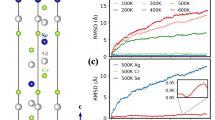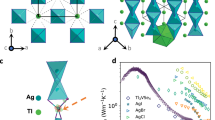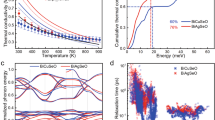Abstract
As a generic property, all substances transfer heat through microscopic collisions of constituent particles1. A solid conducts heat through both transverse and longitudinal acoustic phonons, but a liquid employs only longitudinal vibrations2,3. As a result, a solid is usually thermally more conductive than a liquid. In canonical viewpoints, such a difference also serves as the dynamic signature distinguishing a solid from a liquid. Here, we report liquid-like thermal conduction observed in the crystalline AgCrSe2. The transverse acoustic phonons are completely suppressed by the ultrafast dynamic disorder while the longitudinal acoustic phonons are strongly scattered but survive, and are thus responsible for the intrinsically ultralow thermal conductivity. This scenario is applicable to a wide variety of layered compounds with heavy intercalants in the van der Waals gaps, manifesting a broad implication on suppressing thermal conduction. These microscopic insights might reshape the fundamental understanding on thermal transport properties of matter and open up a general opportunity to optimize performances of thermoelectrics.
This is a preview of subscription content, access via your institution
Access options
Access Nature and 54 other Nature Portfolio journals
Get Nature+, our best-value online-access subscription
$29.99 / 30 days
cancel any time
Subscribe to this journal
Receive 12 print issues and online access
$259.00 per year
only $21.58 per issue
Buy this article
- Purchase on Springer Link
- Instant access to full article PDF
Prices may be subject to local taxes which are calculated during checkout





Similar content being viewed by others
References
Tritt, T. M. Thermal Conductivity: Theory, Properties, and Applications (Klumer Academic/Plenum Publishers, New York, USA, 2004).
Frenkel, J. Kinetic Theory of Liquids (Oxford Univ. Press, London, UK, 1946).
Trachenko, K. & Brazhkin, V. V. Collective modes and thermodynamics of the liquid state. Rep. Prog. Phys. 79, 016502 (2016).
Slack, G. A. in CRC Handbook of Thermoelectrics (ed. Rowe, M.) 407–440 (CRC, Danvers, USA, 1995).
Keppens, V. et al. Localized vibrational modes in metallic solids. Nature 395, 876–878 (1998).
Christensen, M. et al. Avoided crossing of rattler modes in thermoelectric materials. Nat. Mater. 7, 811–815 (2008).
Ravichandran, J. et al. Crossover from incoherent to coherent phonon scattering in epitaxial oxide superlattices. Nat. Mater. 13, 168–172 (2014).
Padture, N. P., Gell, M. & Jordan, E. H. Thermal barrier coatings for gas-turbine engine applications. Science 296, 280–284 (2002).
Siegrist, T., Merkelbach, P. & Wuttig, M. Phase change materials: challenges on the path to a universal storage device. Annu. Rev. Condens. Matt. Phys. 3, 215–237 (2012).
Bell, L. E. Cooling, heating, generating power, and recovering waste heat with thermoelectric systems. Science 321, 1457–1461 (2008).
Gascoin, F. & Maignan, A. Order–disorder transition in AgCrSe2: a new route to efficient thermoelectrics. Chem. Mater. 23, 2510–2513 (2011).
Damay, F. et al. Localised Ag(+) vibrations at the origin of ultralow thermal conductivity in layered thermoelectric AgCrSe2. Sci. Rep. 6, 23415 (2016).
Wu, D. et al. Revisiting AgCrSe2 as a promising thermoelectric material. Phys. Chem. Chem. Phys. 18, 23872–23878 (2016).
Van Der Lee, A. & Wiegers, G. A. Anharmonic thermal motion of Ag in AgCrSe2: A high-temperature single-crystal X-ray diffraction study. J. Solid State Chem. 82, 216–224 (1989).
Murphy, D. W. & Chen, H. S. Superionic conduction in AgCrS2 and AgCrSe2. J. Electrochem. Soc. 124, 1268–1271 (1977).
Onsager, L. Crystal Statistics. I. A two-dimensional model with an order-disorder transition. Phys. Rev. 65, 117–149 (1944).
Louca, D. & Egami, T. Local lattice distortions in La1–xSrxMnO3 studied by pulsed neutron scattering. Phys. Rev. B 59, 6193–6204 (1999).
Cahill, D. G., Watson, S. K. & Pohl, R. O. Lower limit to the thermal conductivity of disordered crystals. Phys. Rev. B 46, 6131 (1992).
Delaire, O. et al. Giant anharmonic phonon scattering in PbTe. Nat. Mater. 10, 614–619 (2011).
Zhao, L. D. et al. Ultralow thermal conductivity and high thermoelectric figure of merit in SnSe crystals. Nature 508, 373–377 (2014).
Li, C. W. et al. Orbitally driven giant phonon anharmonicity in SnSe. Nat. Phys. 11, 1063–1069 (2015).
Lin, H. et al. Concerted rattling in CsAg5Te3 leading to ultralow thermal conductivity and high thermoelectric performance. Angew. Chem. Int. Ed. 55, 11431–11436 (2016).
Minnich, A. J., Dresselhaus, M. S., Ren, Z. F. & Chen, G. Bulk nanostructured thermoelectric materials: current research and future prospects. Energy Environ. Sci. 2, 466–479 (2009).
Kim, S. I. et al. Dense dislocation arrays embedded in grain boundaries for high-performance bulk thermoelectrics. Science 348, 109–114 (2015).
Liu, H. et al. Copper ion liquid-like thermoelectrics. Nat. Mater. 11, 422–425 (2012).
Voneshen, D. J., Walker, H. C., Refson, K. & Goff, J. P. Hopping time scales and the phonon-liquid electron-crystal picture in thermoelectric copper selenide. Phys. Rev. Lett. 118, 145901 (2017).
Hibma, T. in Intercalations Chemistry (eds Whittingham, M. S. & Jacobson, A. J.) 285–313 (Academic Press, London, UK, 1982).
Subbaswamy, K. R. & Mahan, G. D. Renormalization group results for lattice-gas phase boundaries in two dimensions. Phys. Rev. Lett. 37, 642 (1976).
Brüesch, P., Hibma, T. & Bührer, W. Dynamics of the two-dimensional superionic conductor AgCrS2. Phys. Rev. B 27, 5052–5061 (1983).
Aliev, M. I. et al. Production and X-ray studies of AgCrSe2, AgCrTe2, AgNiSe2 and AgNiTe2 compounds. Doklady Akademii Nauk Azerbajdzhanskoj SSR 13, 42–46 (1981).
Neuefeind, J., Feygenson, M., Carruth, J., Hoffmann, R. & Chipley, K. K. The nanoscale ordered materials diffractometer NOMAD at the spallation neutron source. Nucl. Instr. Meth. Phys. Res. B 287, 68–75 (2012).
Toby, B. H. EXPGUI, a graphical user interface for GSAS. J. Appl. Cryst. 34, 210–213 (2001).
Isshiki, M., Ohishi, Y., Goto, S., Takeshita, K. & Ishikawa, T. High-energy X-ray diffraction beamline: BL04B2 at SPring-8. Nucl. Instr. Meth. Phys. Res. B 476–478, 663–666 (2012).
Farrow, C. L. PDFfit2 and PDFgui: computer programs for studying nanostructure in crystals. J. Phys. Condens. Matt. 19, 335219 (2007).
Nakajima, K. et al. AMATERAS: a cold-neutron disk chopper spectrometer. J. Phys. Soc. Jpn 80, SB028 (2011).
Nakamura, M. et al. First demonstration of novel method for inelastic neutron scattering measurement utilizing multiple incident energies. J. Phys. Soc. Jpn 78, 093002 (2009).
Inamura, Y., Nakatani, T., Suzuki, J. & Otomo, T. Development status of software ‘Utsusemi’ for chopper spectrometers at MLF, J-PARC. J. Phys. Soc. Jpn 82, SA031 (2013).
Azuah, R. T. et al. DAVE: A comprehensive software suite for the reduction, visualization, and analysis of low energy neutron spectroscopic data. J. Res. Natl Inst. Stan. Technol. 114, 341–358 (2009).
Fåk, B. & Dorner, B. Phonon line shapes and excitation energies. Physica B 234–236, 1107–1108 (1997).
Kresse, G. & Hafner, J. Ab initio molecular-dynamics simulation of the liquid-metal amorphous-semiconductor transition in germanium. Phys. Rev. B 49, 14251–14269 (1994).
Perdew, J. P., Burke, K. & Ernzerhof, M. Generalized gradient approximation made simple. Phys. Rev. Lett. 77, 3865 (1996).
Kresse, G. & Joubert, D. From ultrasoft pseudopotentials to the projector augmented-wave method. Phys. Rev. B 59, 1758 (1999).
Blöchl, P. E. Projector augmented-wave method. Phys. Rev. B 50, 17953 (1994).
Monkhorst, H. J. & Pack, J. D. Special points for Brillouin-zone integrations. Phys. Rev. B 13, 5188 (1976).
Romero, A. H. et al. Lattice properties of PbX (X=S,Se,Te): Experimental studies and ab initio calculations including spin-orbit effects. Phys. Rev. B 78, 224302 (2008).
Togo, A., Oba, F. & Tanaka, I. First-principles calculations of the ferroelastic transition between rutile-type and CaCl2-type SiO2 at high pressures. Phys. Rev. B 78, 134106 (2008).
Baroni, S., de Gironcoli, S., Dal Corso, A. & Giannozzi, P. Phonons and related crystal properties from density-functional perturbation theory. Rev. Mod. Phys. 73, 515–562 (2001).
Jain, A. et al. The Materials Project: A materials genome approach to accelerating materials innovation. APL Mater. 1, 011002 (2013).
Hautier, G., Fischer, C., Ehrlacher, V., Jain, A. & Ceder, G. Data mined ionic substitutions for the discovery of new compounds. Inorg. Chem. 50, 656–663 (2011).
Acknowledgements
We acknowledge the award of beam time from the Spallation Neutron Source, a DOE Office of Science User Facility operated by the Oak Ridge National Laboratory, via proposal IPTS-13971, from SPring-8 via proposal no. 2015B1070, and from J-PARC via proposal no. 2012P0906. H.W. and R.Q.W. were supported by DOE-BES (grant no. DE-FG02-05ER46237) and the computer simulations were supported by the National Energy Research Scientific Computing Center (NERSC). Ames Laboratory is operated for the US Department of Energy by Iowa State University under contract no. DE-AC02-07CH11358. D.W. and J.Q.H. were supported by the Natural Science Foundation of Guangdong Province (grant no. 2015A030308001) and the leading talents programme of Guangdong Province (grant no. 00201517). H.L.Y. and Y.C. acknowledge the research computing facilities offered by ITS, HKU. We thank M. Kofu for the fruitful discussion.
Author information
Authors and Affiliations
Contributions
B.L. and H.W. planned the project. Q.Z., D.V., D.W. and J.Q.H. synthesized two samples. D.W. and J.Q.H. carried out thermoelectric measurements. X.K.N. measured the low-temperature specific heat and carried out transmission electron microscopy observation. For the sample made by Q.Z. and D.V., M.F. performed neutron powder diffraction measurements, B.L., Y.K. and K.O. collected X-ray scattering data, and B.L., Y.K., T.K., K.S., T.Y. and K.N. performed inelastic neutron scattering measurements. H.W., H.L.Y., Y.C. and R.Q.W. performed theoretical calculations. B.L., H.W., J.Q.H. and M.G.K. interpreted all results and wrote the manuscript with discussion and input from all coauthors.
Corresponding authors
Ethics declarations
Competing interests
The authors declare no competing financial interests.
Additional information
Publisher’s note: Springer Nature remains neutral with regard to jurisdictional claims in published maps and institutional affiliations.
Supplementary information
Supplementary Information
Supplementary Figures 1–13, Supplementary Tables 1–6, Supplementary References
Rights and permissions
About this article
Cite this article
Li, B., Wang, H., Kawakita, Y. et al. Liquid-like thermal conduction in intercalated layered crystalline solids. Nature Mater 17, 226–230 (2018). https://doi.org/10.1038/s41563-017-0004-2
Received:
Accepted:
Published:
Issue Date:
DOI: https://doi.org/10.1038/s41563-017-0004-2
This article is cited by
-
Mobile ion confinement for better thermoelectrics
Nature Materials (2024)
-
Extreme phonon anharmonicity underpins superionic diffusion and ultralow thermal conductivity in argyrodite Ag8SnSe6
Nature Materials (2023)
-
A deeper look into argyrodite phonons
Nature Materials (2023)
-
Spin-orbit coupled spin-polarised hole gas at the CrSe2-terminated surface of AgCrSe2
npj Quantum Materials (2023)
-
Ag9GaSe6: high-pressure-induced Ag migration causes thermoelectric performance irreproducibility and elimination of such instability
Nature Communications (2022)



